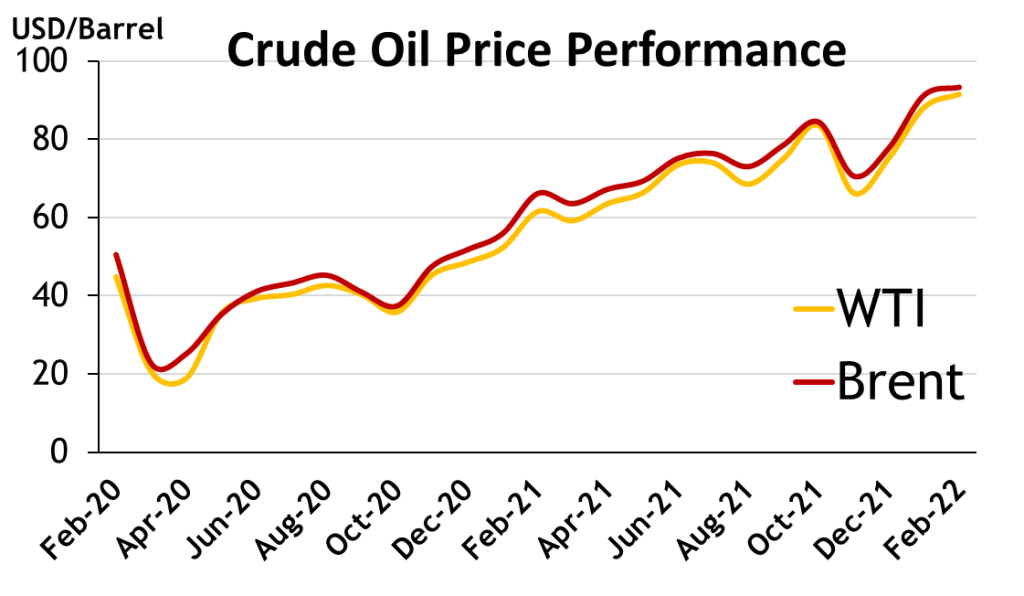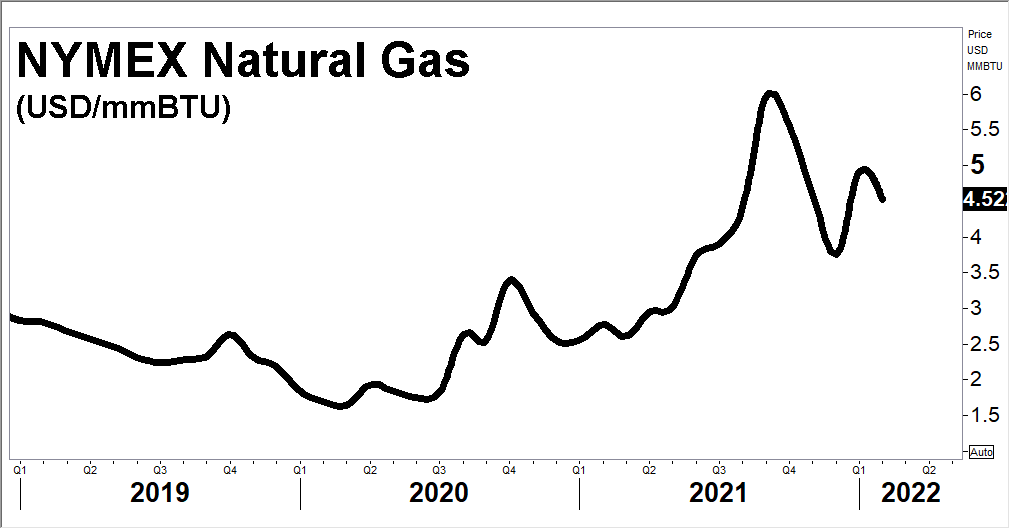by Manu Jacob
Since the second half of 2021 prices of energy commodities have risen higher and have not cooled down so far in 2022. The energy crisis which attracted attention from an economic standpoint in late 2021, continues to do so in early 2022 as well. Its impact widened from industries to households, weighing down growth and accelerating inflation. Not to mention the soaring energy prices have posed some challenges to global economic growth.
For crude oil, the demand growth was faster than the supply during the pandemic period. As the vaccination rates increased and the travel restrictions eased, the demand for petroleum fuels increased. As per Energy Information Administration (EIA), Brent’s 2021 annual average of USD 71 a barrel is the highest in the past three years. The price of West Texas Intermediate (WTI) crude oil traced a similar pattern to Brent and averaged USD 68 per barrel, just USD 3 per barrel less than Brent in 2021. The crude oil prices have hit a new seven year high in the recent months, where the WTI variant crossed the USD 100 per barrel hurdle first time since 2014.

Source: Reuters, Geojit Research
During 2021 crude oil production increased more slowly than demand, lifting the prices to yearly highs. The slower production increase was mainly due to the supply adjustments by Organization of the Petroleum Exporting Countries (OPEC) and its key allies including Russia, known as OPEC+. The OPEC+ decided to continue to limit crude oil production from December 2020. Later in July 2021, the producers group announced its decision to adjust upward their overall production by 400,000 barrels per day on a monthly basis, starting from August 2021. Presently, the OPEC+ is strictly adhering to its strategy of gradual monthly revision of production regardless of repeated requests from US and other consumers to pump adequate oil into the market.
Apart from OPEC+ supply cut agreement and strict adherence, disruption in many oil producing nations also tightened the market. Production outages in Libya and Nigeria and civil unrest in Kazakhstan caused the OPEC+ production to further fall below the targeted production levels. Although the producers group continuously underperformed in meeting the output target for several months, it has not decided to increase production sufficiently to meet the oil demand in the market.
The International Energy Agency reported that the producers outside the OPEC+ alliance were the ones driving world oil supply higher in January. The production from US shale industry is expected to increase further due to increase in prices. Therefore, IEA has raised US oil supply growth for 2022 to 1.2 million barrels per day. Also, other nations such as Canada, Brazil and Guyana could add an additional 460,000 barrels per day between them.
That shortfall is expected to deepen as some OPEC+ members struggle with production constraints, exacerbating market tightness. OECD industry oil inventories plunged by a hefty 60 mb in December, to stand 255 mb below the five-year average and at their lowest level in seven years. Over the past 12 months, industry stocks have declined by 355 mb despite the release of more than 50 mb of oil from government reserves over the same period.
In meeting the energy requirements globally, energy commodities have been moderately deficient during the second half of 2021. Using fossil fuels in power generation contributed to most of the demand growth in energy commodities. A robust transition in natural gas market caused global competition for the gas supplies. Displacement of coal-fired power generation on environmental reasons has improved demand for cleaner fuel, natural gas. However, increasing cost for natural gas forced many industries to switch to crude oil and coal. Subsequently, increasing demand from industrial sector for power generation lifted prices for all alternative fuels including coal, natural gas, and crude oil last year.

Source: Reuters
Increased demand for power generation during hot weather conditions in US in mid- 2021 led to a rally in natural gas prices. Additionally, higher demand from Asian and European countries also propelled the prices. In US, colder-than-normal temperatures during January depleted natural gas inventories to below the five-year average by the end of the month at 2.3 trillion cubic feet. Meanwhile, European nations seem to be facing a shortage in natural gas supplies causing European gas prices to be highly volatile in the past few months.
Threat from Russia-Ukraine crisis
So far in 2022, the Russia-Ukraine tensions have been a major contributor to the surge in energy prices. Russia is a key supplier of crude oil and natural gas to European nations. Russia’s incursion in Ukraine could bring Europe in a direct conflict with its biggest energy supplier. The continent is already facing shortages in energy market, causing many industries to go into either partial or complete shutdown in last few months. Russia provides natural gas to Europe via the Yamal-Europe pipeline through Belarus and Poland, the Blue Stream and TurkStream pipelines to Turkey, and the Nord Stream 1 pipeline to Germany with Nord Stream 2 awaiting certification. European nations have imposed sanctions on Russia because of its attacks on Ukraine. When it comes to crude oil, Russia is a key supplier of oil and a major ally to OPEC nations. Sanctions on Russia could also affect Russian oil exports, and a significant shortage in crude oil market. Presently, these tensions have lifted crude oil prices to yearly highs.
Revival of Iran’s nuclear deal with world powers would lead to lifting US sanctions on Iran’s oil exports. According to IEA, it could potentially bring 1.3 million barrels per day of Iranian oil back into the market. Besides, the US shale production could moderately add up the global oil supplies. However, the limited OPEC+ supplies would keep crude oil prices higher. In the meantime, returning to normal weather in March could calm down natural gas prices in US. Whereas in Europe, increased demand from power generation and prevailing supply shortages may keep European gas prices volatile in the coming months. For both these commodities, tension surrounding Ukraine will be a major concern.







